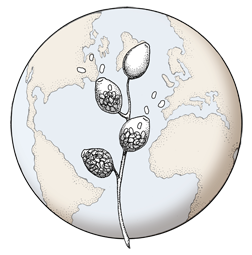Glossary
| Term | Definition |
|---|---|
| lesion |
A localized area of diseased or damaged tissue. |
| mycelium |
A mass of hyphae, often used to denote all hyphae comprising a thallus. (Pl. mycelia) |
| nested proliferation |
A type of internal proliferation where the new sporangia develop successively inside the old sporangia. |
| obovoid |
Inversely egg-shaped; ovoid, but with the widest part at the apex. |
| obpyriform |
Inversely pear-shaped, i.e. with the widest part at the point of attachment. Compare with pyriform. |
| oogonium |
The female gametangium in which the oospore forms after fertilization by the antheridium. (Pl. oogonia) |
| oospore |
Zygote or thick-walled spore that forms within the oogonium after fertilization; may be long-lived. |
| ovoid |
Egg-shaped; the widest part is at the bottom and the narrow part at the apex. |
| papilla |
A small rounded or conic elevation, generally translucent, of the wall of sporangia and gametangia, which on breaking serves as the point of exit of zoospores. |
| papillate |
Having a well developed papilla. |
| paragynous |
Pertaining to the sexual stage in which the antheridium is attached to the side of the oogonium. Compare with amphigynous. |
| pedicel |
A slender stalk or support of spores, sporangia, cystidia, asci, etc. |
| pedicel length |
The length of pedicel on a sporangium after shedding by caducous species; three divisions are recognized by Gallegly and Hong: short, <5µm; intermediate, 5-20µm;and long, >20µm. |
| persistent |
Applied to structures that remain after their function has ceased; e.g., sporangia that remain in place after sporulation. Compare with caducous. |
| plerotic |
to be full; e.g., a plerotic sporangium is one which is full of spores; a plerotic oospore is one that fills the oogonium. Compare with aplerotic. |
| proliferation |
Successive development of new sporangiophores; internal proliferation occurs when the sporangiophore continues to grow through the empty sporangium; external proliferation occurs from growth of a sporangiophore from beneath and external to a sporangium. |
| pyriform |
Pear shaped, with the narrowest part at the base. Compare with obpyriform. |
| reniform |
Kidney shaped. |
| semi-papillate |
Having papilla that are not well developed, shallow and less nipple-like than fully papillate structures. |
| simple sympodium |
An unbranched sympodium with a single sporangium produced externally from the base of the previous sporangium. |
| sporangiophore |
The hyphal strand on which the sporangium is formed; may be branched or unbranched to form compound or simple sympodia. |
| sporangium |
A sac that bears endogenous, asexual spores. In Phytophthora, zoospores are produced in a sporangium. (Pl. sporangia) |
| sympodium |
A type of sporangiophore which appears simple, but where each successive sporangium develops on a branch behind and to one side of the previous apex, where growth has already ceased. (Pl. sympodia) |
| wilt |
Foliage becomes flaccid due to a water deficit. This is often the first aboveground symptom of root rot. |
| zoospore |
Spore that forms within the sporangium and exits through the terminal pore and is capable of swimming for several hours. In Phytophthora, each zoospore has a tinsel flagellum and a whiplike flagellum. |


